In last month’s Cooper Hewitt Short Story, we roamed the halls of the Cooper Union Museum for the Arts of Decoration in 1939, exploring past and present methods of collection display. This month, Julie Pastor, curatorial assistant at Cooper Hewitt, lavishes us with drawings of jewelry, many collected by the Hewitt Sisters, from the holdings of esteemed collectors in the field.
Margery Masinter, Trustee, Cooper Hewitt, Smithsonian Design Museum
Sue Shutte, Historian at Ringwood Manor
Matthew Kennedy, Publishing Associate, Cooper Hewitt, Smithsonian Design Museum
JAUNTY JEWELS: Collecting designs for jewelry
As a part of the purchases of more than 11,000 drawings from the collection of Giovanni Piancastelli made by Sarah and Eleanor Hewitt in 1901 and the museum in 1938, a wealth of 18th- and 19th-century Italian designs for jewelry entered Cooper Hewitt’s collection. Piancastelli acquired jewelry designs from a variety of individual workshops, and the group represents diverse pendants, earrings, brooches, bracelets, necklaces, hair combs, and diadems. Most of these drawings are unattributed to particular draughtsmen or workshops, and nothing is known about the existence of pieces of jewelry that match the intricate examples on paper. Why then were these drawings created, and how might they have been used?
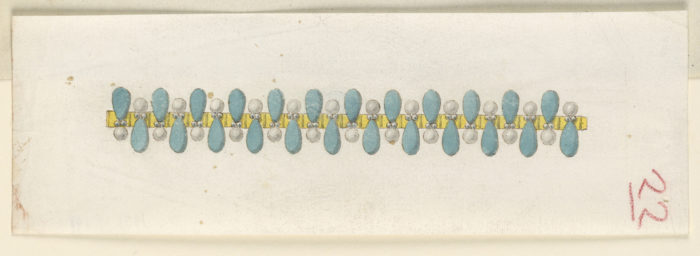
Drawing, Design for a Bracelet (Italy), early 19th century; Pen and black ink, brush and gray wash, green and yellow watercolor, graphite on white laid paper; 9.1 × 27.6 cm (3 9/16 × 10 7/8 in.); Museum purchase through gift of various donors and from Eleanor G. Hewitt Fund, 1938-88-690
Preparatory drawings were essential exercises in a jeweler’s workshop. Due to the high value and cost of a jeweler’s materials, apprentice jewelers began creating decorative designs on paper before they would experiment directly with expensive fine metals and gems. Master jewelers also brought finer ideas to life on paper for study, for printed reproduction and circulation, or as part of a portfolio that served as a record of executed pieces. Working with clients on custom jewelry required new drawings to be made so that the commissioned piece could uniquely match the client’s individual tastes—with such a level of customization, jewels in such luxurious materials were only available to the extremely wealthy.
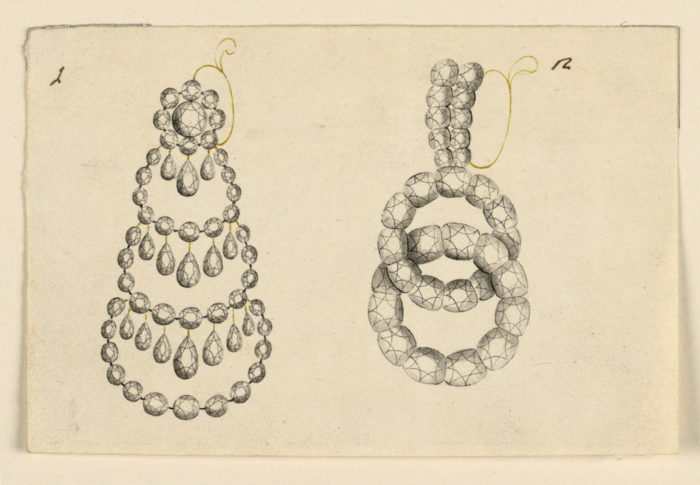
Drawing, Two Designs for Earrings (Italy), early 19th century; Pen and ink, brush and gray and olive watercolor on wove paper; 9.4 × 14.3 cm (3 11/16 × 5 5/8 in.); Museum purchase through gift of various donors and from Eleanor G. Hewitt Fund, 1938-88-778
Many of the drawings in this collection were likely created to spark discussions with clients. Though we might think of jewelry as bright and colorful, drawings made in black and white allowed the materials to be discussed in conversation and could perhaps allow one drawn design to be modified to suit the unique preferences of several customers. Masters also kept drawings that illustrated excellent work by other jewelers as a way of documenting inspiration and staying aware of trends in the market.[i]
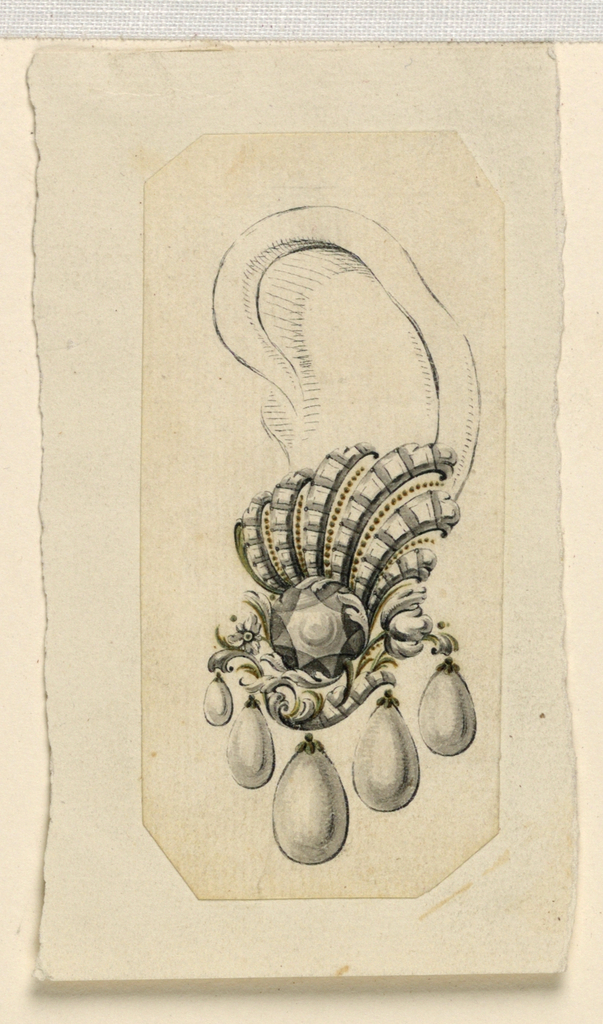
Drawing, Design for an Earring, ca. 1755; Designed by Giovanni Sebastiano Meyandi (Italian, active 1762–1794); Pen and ink, brush and green and brown watercolor on paper; 10.7 × 5 cm (4 3/16 × 1 15/16 in.); Museum purchase through gift of various donors and from Eleanor G. Hewitt Fund, 1938-88-873
In addition to illuminating workshop practices, the drawings also document changing tastes. Early 18th-century forms show the continued interest in rococo style, with asymmetrical jewelry designs that combine natural and abstract motifs.[ii]
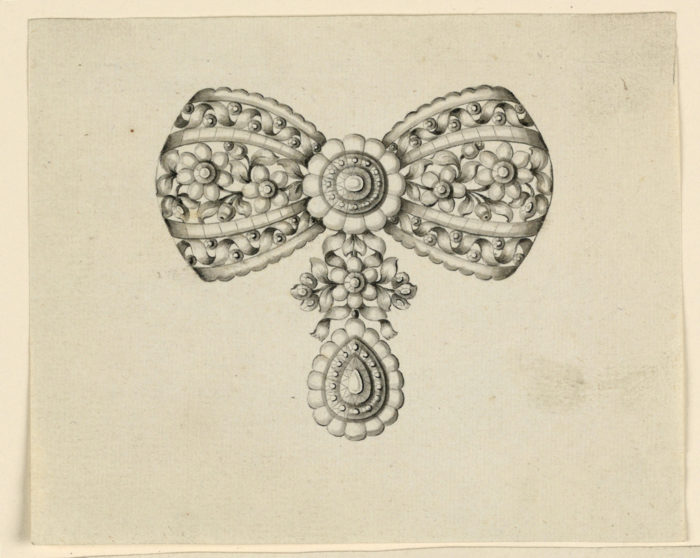
Drawing, Design for a Brooch (Italy), late 18th century; Pen and black ink, brush and gray watercolor on off-white laid paper; 12.3 × 15.2 cm (4 13/16 in. × 6 in.); Museum purchase through gift of various donors and from Eleanor G. Hewitt Fund, 1938-88-799
The bow-knot form illustrated in many examples was popular in the second half of the 18th century, often adorning the sleeve or attracting attention as the center of a necklace.[iii]
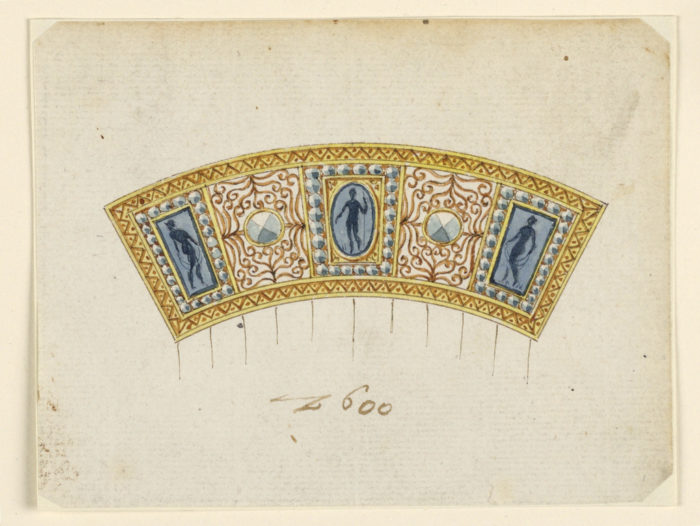
Drawing, Design for a Comb (Italy), ca. 1810; Pen and brown ink, brush and watercolor on white laid paper, laid down; 10.9 × 13 cm (4 5/16 × 5 1/8 in.); Museum purchase through gift of various donors and from Eleanor G. Hewitt Fund, 1938-88-701
A new emphasis on hair adornments in the late 18th and early 19th centuries favored hair combs, crowns, and diadems. By the 19th century, the growing numbers of the elite class demanded greater quantities of jewelry, which became available to a slightly larger consumer base.[iv]
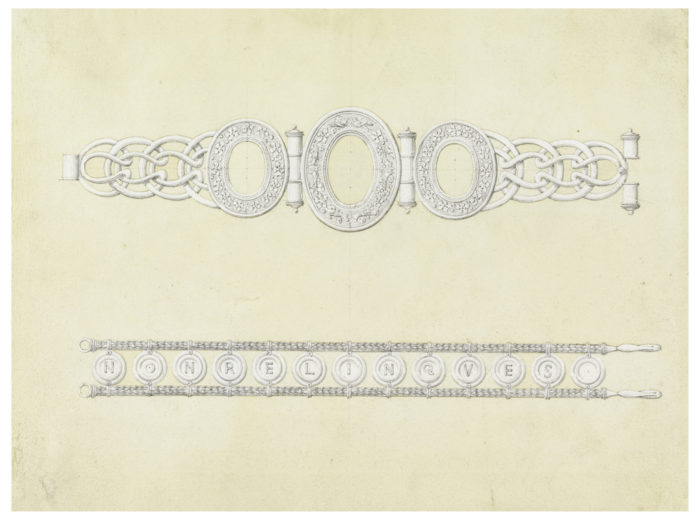
Drawing, Design for two bracelets, ca. 1858–80; Attributed to Augusto Castellani (Italian, 1829–1914); Pen and black ink, graphite, brush and pale yellow wash on white wove paper; 23.9 x 18.1 cm (9 7/16 x 7 1/8 in.); Museum purchase through gift of various donors and from Eleanor G. Hewitt Fund, 1938-88-6353
Though most of this group of Italian jewelry designs is unattributed to particular designers, a few exceptional examples are the work of known masters. A pair of exquisite designs for bracelets and watch chains, executed by Augusto Castellani, also demonstrates a departure from the ornamental style of the 18th century and a new interest in reviving antique forms. The excavation of Herculaneum and Pompeii, begun in the 18th century, reintroduced Italians to classical Etruscan, Greek, and Roman jewelry. Fortunato Pio Castellani (1793–1865), father to both Augusto (1829–1914) and Alessandro (1823–83) and the head of the family’s jewelry firm, gained a prestigious reputation in the 19th century for the revival of lost classical techniques, especially the once widespread art of granulation.[v]
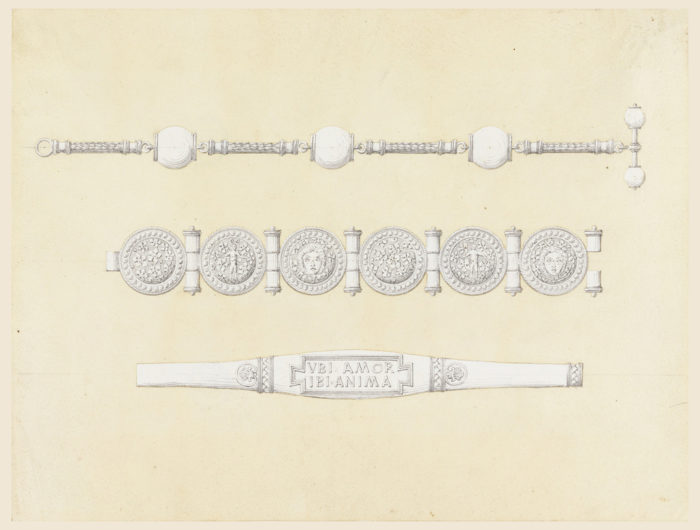
Drawing, Design for a watch chain and two bracelets, ca. 1870; Attributed to Augusto Castellani (Italian, 1829–1914); Graphite, brush and pale yellow wash on white wove paper; 23.8 x 18 cm (9 3/8 x 7 1/16 in.); Museum purchase through gift of various donors and from Eleanor G. Hewitt Fund, 1938-88-6352
Particularly visible in the round medallions of these bracelets, granulated decoration consists of applying tiny, extremely fine globules of gold to another gold surface. This skillful technique allowed the jeweler to build up a delicate surface pattern or texture of geometric or natural forms. Already popular in the 19th century, Italian archaeological revivalism might have seemed even more fashionable after the unification of Italy in 1870, when antique techniques could be celebrated as a symbol of national pride. Though not a direct analogue to the antique jewelry designs above, a medieval bracelet in Cooper Hewitt’s collection points to the breadth of the Castellani firm’s production of historical styles.[vi]

Bracelet (Italy), ca. 1880; Made by Fortunato Pio Castellani & Sons (Italy); Gold, emeralds; 3 x 21.8 x 0.9 cm; Museum purchase through gift of Anonymous Donor, Annie Schermerhorn Kane, and various donors, 1969-40-23
Though these rich designs capture the gestures of Italian workshops and a wide range of styles and tastes, jewelers did not draw in isolation. Engravings provided a vast reference of reproducible models for jewelers, and the greater circulation of prints meant that styles could extend across geographical and historical borders. Masters collected prints as inspiration, and they published some of their own designs as prints to further their reputation, at times choosing to illustrate designs so complex and fanciful that they could never be executed in real life.[vii] Considering even earlier historical jewelry designs in Cooper Hewitt’s collection, such as prints by 16th-century masters Hans Collaert (Flemish, ca. 1530–1581) and René Boyvin (French, ca. 1525–ca. 1625), demonstrates a markedly different vocabulary of jewelry forms.
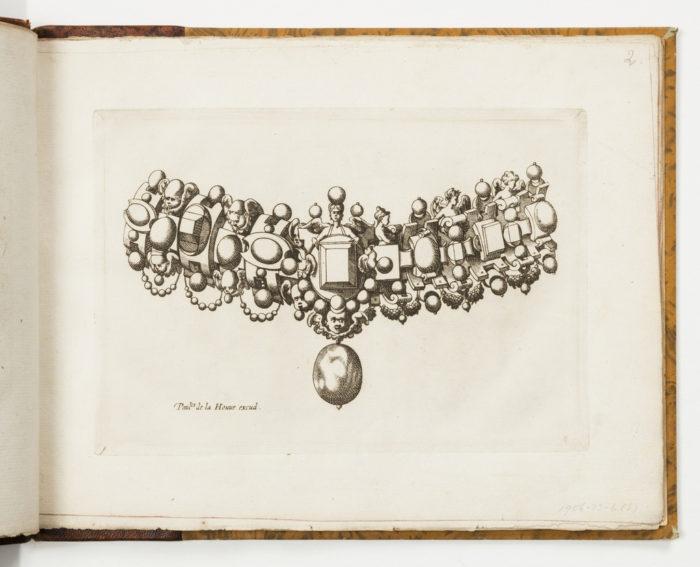
Print, Plate 2, from Livre de bijouterie (Book of Designs for Goldsmiths and Jewelers), ca. 1570; Engraved by René Boyvin (French, ca. 1525–ca. 1625); Engraving on paper; 15.8 × 20.5 cm (6 1/4 × 8 1/16 in.); Museum purchase through gift of Eleanor and Sarah Hewitt, 1956-23-6-2
Architectural elements were popular jewelry motifs in the 16th century—the rectangular chain and figures of this collar by Boyvin treat the decoration of the body as the ornamentation of a building. The dangling garlands of gems likewise reference architectural ornament.
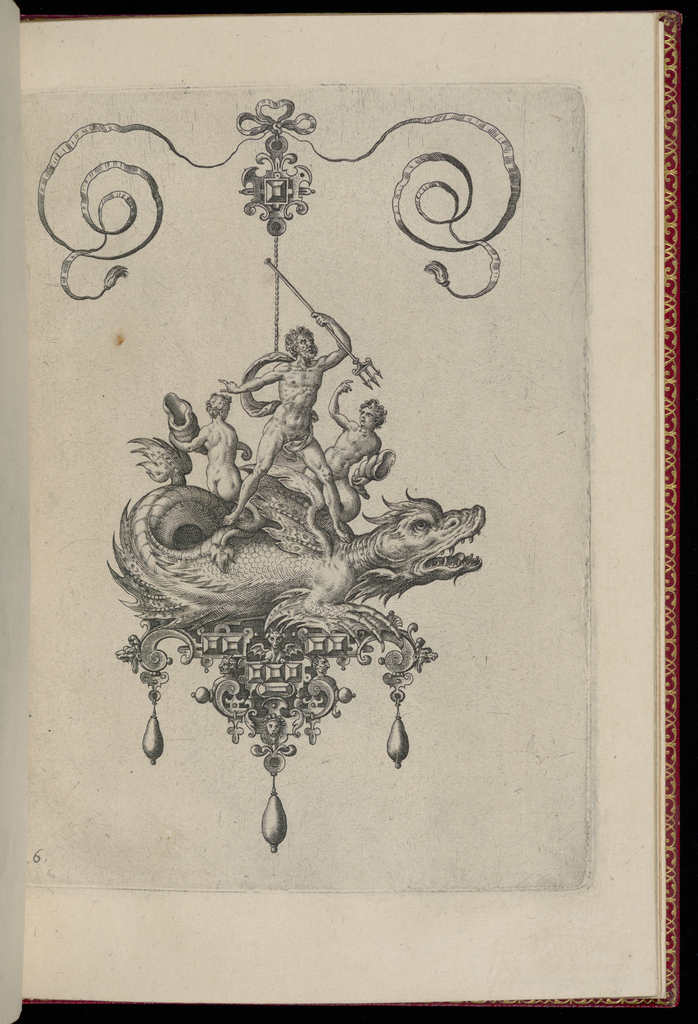
Print, Plate 6, from Bullarum Inaurium etc. Archetypi Artificiosi Pars Altera (Pendants, Earrings, etc. Designs of the Most Skillful Nature, Part Two), 1582; Designed by Hans Collaert the Elder (Flemish, ca. 1530–1581); Engraving on paper, laid and gilded; 21.3 × 14.5 cm (8 3/8 × 5 11/16 in.); Purchased for the Museum by the Advisory Council, 1921-6-469-16
This design by Collaert represents a much less abstract approach, though scenes of figures riding on the backs of monsters were common at the time.[viii] This mythical beast might have been executed from an irregularly shaped pearl, which would appear dynamically iridescent as it swung from the robes of its wearer.
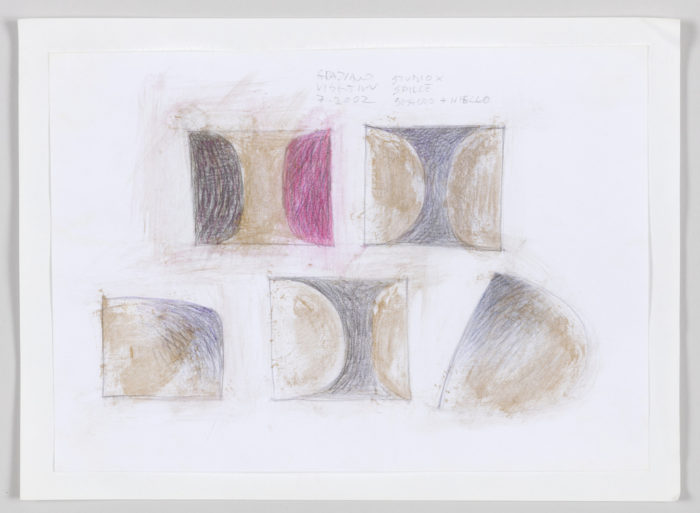
Drawing, Designs for a Brooch, 2002; Designed by Graziano Visintin (Italian, b. 1954); Graphite, black and red color pencil, brush and gold paint on cream wove paper mounted on white wove paper; 9.5 × 13 cm (3 3/4 × 5 1/8 in.); The Susan Grant Lewin Collection, Cooper Hewitt, Smithsonian Design Museum, 2017-45-1
Continuing to represent changing styles and forms, designs for jewelry have remained an important aspect of the museum’s collection. Among the rich examples of 20th-century jewelry recently acquired in the Susan Grant Lewin Collection are several examples of preparatory drawings. Just as in the historical drawings and prints in the museum’s collection, these studies document the importance of drawing in a jeweler’s design process, illustrating studies in color and form important to the execution of a completed work.
Sources
[i] Cooper Union Museum for the Arts of Decoration, “Italian Drawings for Jewelry: 1700–1875” (New York: Cooper Union Museum, 1940), 1–2.
[ii] Jean Lanillier and Marie-Anne Pini, Five Centuries of Jewelry in the West (New York: Leon Amiel, 1983), 133.
[iii] Cooper Union Museum for the Arts of Decoration, 8.
[iv] Marie-Louise d’Otrange Mastai, Jewelry (New York: Cooper Hewitt Museum, 1981), 87.
[v] Shirley Bury, “Alessandro Castellani and the Revival of Granulation,” The Burlington Magazine vol. 117, no. 871 (Oct. 1975): 667.
[vi] Susan Weber Soros and Stefanie Walker, Castellani and Italian Archeological Jewelry (New Haven: Yale University Press, 2005), 56.
[vii] Cooper Union Museum for the Arts of Decoration, 2.
[viii] Joan Evans, A History of Jewelry 1100–1870 (Boston, MA: Boston Book and Art, 1970), 112–113.

One thought on “Cooper Hewitt Short Stories: Designs for Jewelry”
Barbara Raleigh on February 5, 2018 at 3:16 pm
I have many folders of original jewelry drawings , fine and costume, from the early to mid 1900’s. Would you like toes my collection?